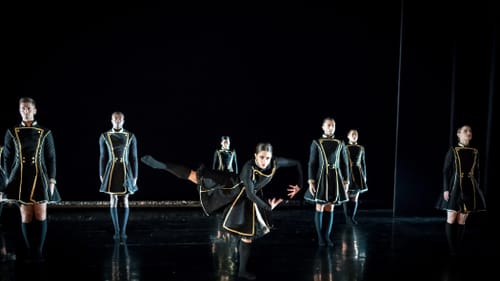Stay in the Loop
BSR publishes on a weekly schedule, with an email newsletter every Wednesday and Thursday morning. There’s no paywall, and subscribing is always free.
Bridging nations, rising above
Balletx presents 'Fall Series 2018' with Marguerite Donlon, Wubkje Kuindersma, and Cayetano Soto

The BalletX Fall Series includes three world premieres from international choreographers: Wubkje Kuindersma of the Netherlands, Marguerite Donlon of Ireland, and Cayetano Soto of Spain. These works form an international dance summit that takes the audience on a journey through time, place, and emotion. Together, the three dances reckon with the past, comment on the present, and imagine a collective future.
BalletX’s commitment to premiering new work from diverse choreographers ensures a new experience each season. The result includes pieces of varying effectiveness, as is the case in this Fall Series. Yet the relatively small company unfailingly rises to the challenge of performing in different styles and traditions and portraying complex emotions and relationships, all with mastery and grace. World premieres allure, but BalletX’s dancers always carry the performance.
The Last Lifeboat
This was the case for “The Last Lifeboat,” which tells the true story of 16-year-old Kate Gilnagh’s rescue from the sinking Titanic. “Lifeboat” has the makings of a crowd-pleaser: it strikes chords similar to the popular and enduring 1997 movie Titanic, and it has personal significance to choreographer Marguerite Donlon, who is Gilnagh’s great-niece. But the dance did not cohere, despite strong performances from Chloe Perkes and Zachary Kapeluck as Gilnagh and her savior and inventive use of three wooden panels to dramatize time running out and walls closing in.
Perkes and Kapeluck wore suitably old-timey garments, but I could not make sense of Mark Eric’s costumes for the rest of the company: black coatlike garments that opened in front to reveal shorts (and bra tops for the women), later swapped for modern-looking nude costumes. More perplexing was the role of these other dancers. Who, or what, did they represent? And why was their dancing punctuated with odd percussive vocalizations?
As sinking approached, a series of partner dances suggested emotion, memory, and narrative impression. Andrea Yorita and Roderick Phifer made a well-matched pair as she extended and folded her body into a swan shape while he lifted her. Richard Villaverde and Skyler Lubin danced a duet for parting lovers, while Caili Quan’s face registered palpable sadness in a trio with Blake Krapels and Stanley Glover.
The work’s final scene recalled the film starring Kate Winslet and Leonardo Dicaprio: moving but predictable, with a hint of schmaltz.

Napoleon/Napoleon
Cayetano Soto’s “Napoleon/Napoleon” explored tyranny and childishness. Soto’s program notes describe inspiration from the so-called Emperor’s Syndrome, a global phenomenon in which children become “bosses” of their families. However, “Napoleon/Napoleon” struck me as thinly veiled political allegory.
This dance combined the serious with the ridiculous to reflect adult immaturity, particularly from leaders. Stephen Smith’s costumes conveyed the message with military-inspired coats that would be imposing if dancers’ legs were not bare beneath them.
Similarly, the drama of music by composers including Shostakovich and Vivaldi was undermined by gimmicky sequences. These included kid-sized tricycles and digital signs scrolling quotes from the work’s titular emperor, such as “The surest way to remain poor is to be an honest man.”
Dancers postured like self-important officials, marched like marionettes, and performed hopping arabesques and stutter steps evoking powerful yet ineffective leaders. Like Garry Trudeau’s satirical comic Doonesbury, “Napoleon/Napoleon” aims to laugh at current events. The audience indeed laughed, but I found the dance’s desperate emperors more depressing than entertaining. Nevertheless, I admire what Soto attempted to achieve.

Yonder
In contrast, Wubkje Kuindersma’s “Yonder” offered a meditation on collaboration. Billed as a “Skype ballet,” this dance initially developed over international video calls due to issues with the choreographer’s visa, but it fosters human connection through nature rather than technology.
“Yonder” looks to a place we hope to move toward. Kuindersma explains that “connecting our personal Yonder” to others allows us to “become a horizon of hopes and dreams.” The work realized the beauty and optimism of these sentiments in a dance of liberation and unity.
Francesca Forcella, in a blue dress, seemed to free grey-clad dancers behind a sheer curtain. She lured them out and gathered them together like a mother hen, an image reinforced by deep backbends and birdlike shapes Forcella made with her arms.
Another section drew upon water and waves as the dancers circled their arms and shoulders as if diving or swimming. When the company formed a circle around Forcella and lifted her, she looked like the stamen of a flower.
Mark Stanley’s gorgeous lighting created moods and setting on a bare stage, and music by Laurie Anderson and the Kronos Quartet contributed to the piece’s otherworldly quality. I did not care for the final scene’s use of Antony and the Johnsons’ cover of “Imagine”; the switch to popular music with lyrics was jarring, and John Lennon’s 1971 song is untouchable. The song is also is too literal for Kuindersma’s ethereal visions, which, aside from this misstep, invite viewers to do their own imagining.
Depending on your perspective, the future — of the performing arts, interpersonal connection, the city, nation, planet, humankind — may look hopeful or bleak. Should we laugh or cry?
BalletX’s Fall Series grapples impressively with these pressing issues in an imaginative program engaging a full range of questions and emotions. In the process, this program reaffirms the power of dance to express the ineffable during troubled times.
What, When, Where
BalletX Fall Series 2018. "The Last Lifeboat," choreography by Marguerite Donlon; "Napoleon/Napoleon," choreography by Cayetano Soto; "Yonder," choreography by Wubkje Kuindersma. November 28 through December 9, 2018, at the Wilma Theater, 265 S. Broad Street, Philadelphia. (215) 545-7824 or BalletX.org.
Sign up for our newsletter
All of the week's new articles, all in one place. Sign up for the free weekly BSR newsletters, and don't miss a conversation.
 Melissa Strong
Melissa Strong